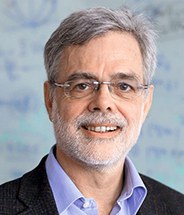Birth: 29.01.1957 in D-66538 Neunkirchen/Saar, Germany
Affiliation: Quantum Theory of Materials (PGI-1/IAS-1)
Peter Grünberg Institut (PGI)
and Institute for Advanced Simulation (IAS)
Forschungszentrum Jülich, Germany
D-52425 Jülich, Germany
and University RWTH Aachen
Phone: [+49] 2461-61-4249
Fax: [+49] 2461-61-2850
E-Mail: s.bluegel@fz-juelich.de
http://internet-live.fz-juelich.de/profile/bluegel_s/
Position: Director of Institute Quantum Theory of Materials at Forschungszentrum Jülich
Professor (C4) for Theoretical Physics at University RWTH Aachen
ORCID iD: 0000-0001-9987-4733
WoS ResearcherID J-8323-2013
Scopus AuthorID 10640602400
Scientific degree: Habil., Dr. rer. nat., Dipl. Phys., Dipl. Ing. (FH)
Prof. Dr. Stefan Blügel (H-index: 79) published more than 580 refereed papers in international journals that had been cited about 28000 times, contributed to more than 30 book chapters and 3 patents, presented about 250 invited talks at international conferences/symposia/meetings (Web of Science 2023-05-10) and educated more than 40 PhD students.
Research Interest:
Theory of electronic properties in real solids, treatment of electron excitations and correlations; structural, magnetic and chemical properties of bulk solids, solids with imperfections, interfaces, surfaces and nanostructures of a type relevant to basic and applied science in the field of nanoelectronics; theory of spintronics, magnetoelectronics, molecular electronics and nanoferronics; physics of low-dimensional materials; magnetism at the spatial limit, complex magnetism, molecular magnetism; theory of STM and AFM; microscopic understanding of growth processes; computational condensed matter, high-performance computing, large-scale ab initio, i.e. based on density functional theory or many body perturbation theory (GW, T), quantum mechanical computer calculations, multiscale modeling, development of numerical and computational methods, development of electronic structure methods; FLAPW, SPEX, KKRnano development.
Education | ||
| 1974-1977 | Study of Mechanical Engineering, Fachhochschule des Saarlandes, Degree Dipl. Ing. (FH) | |
| 1977-1984 | Study of Physics, University of Saarbrücken and Rheinisch-Westfälische Technische (RWTH) Aachen University in Germany, Diplom in Physics, Institut für Festkörperforschung (IFF), Forschungszentrum Jülich | |
| 1984-1985 | College of William and Mary, Williamsburg, VA, USA | |
| 1984-1988 | Research Assistant, Forschungszentrum Jülich | |
| 1988 | Ph.D. in Physics at RWTH Aachen University Institut für Festkörperforschung (IFF), Forschungszentrum | |
| 1988-1990 | Postdoctoral Fellow, University of Tokyo in Japan with Prof. K. Terakura | |
| 1996 | Habilitation at RWTH Aachen University Institut für Festkörperforschung (IFF), Forschungszentrum Jülich | |
Employment History: | ||
1990-2001 | Principal Investigator, Forschungszentrum Jülich | |
2001-2003 | Professor (C3) for Theoretical Physics, University of Osnabrück | |
since 2002 | Foundation of Institute Quantum Theory of Materials | |
since 2003 | Professor for Theoretical Physics, RWTH Aachen University | |
2006 | Executive Director of the Department Institut für Festkörperforschung (IFF), Forschungszentrum Jülich | |
2008–2018 | Chair of several academic hiring committees at RWTH-Aachen and FZJ | |
2009 | Founding member of the Institute for Advanced Simulation, Forschungszentrum Jülich | |
since 2010 | Director at the Institute for Advanced Simulation (IAS), Forschungszentrum Jülich, Institute IAS-I: Quantum Theory of Materials | |
2012 | Executive Director of the Department Institute for Advanced Simulation (IAS), Forschungszentrum Jülich | |
2012 | Speaker of several committees of the Helmholtz Association (HGF) related to Spintronics and Computing | |
2016 | Founding Director of the JARA Center for Simulation and Data Science of RWTH-Aachen and Forschungszentrum Jülich, Germany | |
2016 | Managing Director of the Institute for Advanced Simulation (IAS), FZJ, Germany | |
2017 | Managing Director of the Peter-Grünberg Institute (PGI), FZJ, Germany | |
2021 – Present | Executive Director of the Department Institute for Advanced Simulation (IAS), Forschungszentrum Jülich (FZJ) | |
Honours and Awards: | ||
1983 | Springorum Memorial Medal, RWTH Aachen | |
1984-1985 | Scholarship, German Academic Exchange Service (DAAD) | |
1988 | Friedrich Wilhelm Prize, RWTH Aachen | |
1988-1990 | Feodor Lynen Fellowship, Alexander von Humboldt Foundation | |
1993 | Heinz Maier Leibnitz Prize, German Federal Secretary for Research and Technology | |
1994 | Academy Award, Academy of Sciences of the State North Rhine Westfalia | |
1994 | Member of the Academy of Science of the State North Rhine Westfalia | |
2001 | Offer of full professor position (C4) at University of Kaiserslautern, offer declined (2002) | |
2016 | Lee-Hsun-Lecture Award, Institute of Metal Research, Chinese Academy of Science, Shenyang | |
2019 | ERC Synergy Grant 3D MAGiC – Three-dimensional magnetization textures: Discovery and control on the nanoscale | |
Service to the Community: | ||
2004-2008 | BESSY, Beamtime Review Committee (Electronic Structure and Magnetism) | |
since 2006 | Member of the Scientific Steering Committee of Psi-k | |
2006-2011 | Member of Scientific Advisory Board of John von Neumann Institute for Computing (NIC) | |
2006-2010 | Member of committee Gustav-Herz-Preis of the German Physical Society | |
2006-2011 | Member of the scientific advisory board of the Finish Center of Excellence Computational Nanoscience (COMP) | |
2008 | Chairman (elected) Gordon Research Conference on Magnetic Nanostructures | |
2009-2011 | Vice Chairman of JARA-HPC (Jülich Aachen Research Alliance, Section High Performance Computing) | |
2009-2011 | Membership in the Scientific Selection Panel of the Helmholtz-Zentrum Berlin for Materials and Energy | |
since 2010 | Member of the Council of CECAM (Centre Européen de Calcul Atomique et Moléculaire) | |
2011-2016 | Chairman of Scientific Advisory Board of the Max Planck Institute for Microstructure Physics, Halle (Saale) | |
since 2014 | Steering Committee of the Magnetism Division of the German Physical Society Member of the Board of Trustees of Psi-k Network | |
2018 | Member of international review panel assessing Applied Physics at TU Twente | |
since 2020 | Vice President of CECAM (Centre Européen de Calcul Atomique et Moléculaire) | |
2020 | Member of international review panel assessing the Institute for Solid State Physics (ISSP) at Tokyo University | |
2021 | Member of review panel NT-M Physics of Light and Matter at Swedish Research Council | |
Since 2023 | President of CECAM (Centre Européen de Calcul Atomique et Moléculaire) |

